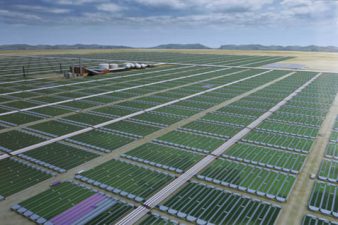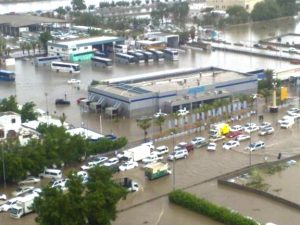This Marine Drone could clean up our dirty work. Can a wealthy Saudi fund this prototype to clean our seas? Fourteen billion pounds of garbage, 90 percent of which is plastic, is dumped into the ocean every year and there is no sign of plastic waste reducing – in fact plastic waste has been increasing about 10% each year for the past 20 years.
In the Red Sea, Arabian Sea, Gulf of Oman, Persian Gulf and the Gulf of Aden, dumping untreated sewage and Industrial waste directly into the sea is unfortunately an extensive practice, but an additional recent threat is the increasing number of landfill sites located near the coast which are resulting in considerable plastic pollution near coasts and coral reefs. One solution, the Marine Drone Elie Ahovi Industrial Design, could clean up our waste.
In response to a question by Veolia Environmental Services on how to collect plastic from the sea, a team of innovative industrial designers propose a Marine Drone (pictured above) capable of capturing drifting plastic.
The drone is basically a propelled oversized pool net with special sensors that keep aquatic animals away and high-powered batteries that allows it to stay in the water for more than 2 weeks. Not much has been discussed regarding how much plastic each drone would be able to collect, the costs involved and whether the drone is capable of capturing the insidious nurdles which are the greatest problem.
Ten percent of all plastic ends up in the ocean, and has resulted in the largest landfill in the world: the Great Pacific Garbage Patch which is estimated to be twice the size of France. The Mediterranean is not spared from floating plastic garbage islands. Seventy percent of this ever-accumulating plastic sinks to the sea floor. In 2006, The United Nations Environment Program estimated that every square mile of ocean hosts 46,000 pieces of floating plastic and in some areas, the amount of plastic outweighs the amount of plankton by a ratio of six to one.
Americans buy over 29 million bottles of water every year, this uses 17 million barrels of crude oil annually, which would be enough fuel to keep 1 million cars on the road for one year. Only 13% of those bottles are recycled. The United Arab Emirates has the world’s largest per-capita ecological footprint; it currently consumes 25% of global plastic bags.
Aside from being a quantitative disaster in our sea, plastic has terrible properties. Once in the ocean there is no way plastic can completely biodegrade. Instead, plastic photodegrades breaking into smaller and smaller pieces of plastic called mermaid tears or nurdles. These tiny plastic particles can get sucked up by filter feeders and are ingested by marine animals which can poison them and lead to death. Nurdles also tend to soak up toxic chemicals which result in biomagnification a process whereby persistent organic pollutants and concentration of toxins increase as we move up trophic levels.
 The issue of plastic waste in our sea cannot be stressed enough, the figures are shocking.
The issue of plastic waste in our sea cannot be stressed enough, the figures are shocking.

But if this prospective Marine Drone project is eventually engineered who would pay to clean up the sea? The sea is a public good and water pollution is the result of several countries dumping so my question is: Are there the right incentives for countries in the Middle East to decide to invest in such ideas and maintain the common sea clean?
:: Elie Ahovi Industrial design







@ Steve — agreed. The Marine Drone could actually be a profitable deal. With increasing oil prices, plastic is increasingly becoming an expensive material and recycling plastic will become a profitable business.
Surely a key element is to utilise the plastic waste collected. There are several fuel from plastic pyrolysis systems that could do this. In this way – provided that the waste can be collected – you may have a self funding technology/business.
I also assume that the faster and earlier the issue of collecting plastic is addressed, the larger the particles and the easier they are to collect.
Regarding the benefits of stopping the discharge of plastic in the first place – which is the ideal correct action, it reminds me of a cartoon I once saw of a man on a mountain top dreaming. The cation said “If a man waits until his actions are perfect, he will never do anything at all!”
@ Andy—Thank you so much for your comments. Although I agree with you regarding the importance of having figures that accurately depict the scale of the plastic problem in our oceans, I do not believe we should wait to have such accurate information to start to worry about it seriously. Really there should be NO plastic in the sea.
Saying “the Great Pacific Garbage patch is twice the size of France” gives readers a sense of the estimated size of the problem. It is easier to picture twice the size of France than an estimated 100 million tons. Texas and France are approximately the same size, I am guessing Texas was a more suitable anecdote for American Readers?
As you say, It is extremely hard to accurately measure the scale of the problem, but that does not mean Environmentalists should not make claims based on current or past research, which of course may need to be revised to improve scientific rigor and methodology, but this is a normal process all science has to undergo. The important thing is to start somewhere.
The number 6:1 is not purely a guess, it was based on a research done by the Algalita foundation ( again I am not saying this was done accurately as discussed here: http://theoystersgarter.com/2008/06/10/is-there-really-six-times-more-plastic-than-plankton-in-the-north-pacific-gyre/ , but it is a starting point and scientists can improve on the methods used to reach more accurate figures). But the plastic/plankton ratio serves a good anecdote for relative abundance of plastic to available food for fish and filter feeders. Of course not all areas in the sea will have such a ratio…
You say “We know that the numbers of creatures dying from ingesting plastic is huge but we do not have accurate numbers” – Why do we absolutely need to have accurate numbers? Shouldn’t the fact that we know the figures are “huge” worry us in itself? Shouldn’t the testimony of scientists in the field and community members be enough? I understand that funding for projects is often contingent on figures, but this mentality leads to NGOs and the government acting only when the problem is severe – only when it is visible to scientists- which could be too late. I have come across several cases where unnecessary money was poured into scientific research to obtain figures which proved what we already knew. If only that money had been invested in SOLVING the problem.
The Drone seems like a crazy idea, I agree. But really the best solution would be to stop using plastic and clean up as much of the plastic mess as we can (drone being one possible idea). Policy is very important here.
We must stop saying things like ‘the Great Pacific Garbage patch is twice the size of France’. I’ve also seen it described as twice the size of Texas or twice the size of the United States. Obviously this is incorrect as it is assuming that all this plastic has gathered together in one area of the ocean. There is no sign of this garbage patch even up close. Environmentalists lose credibility when they make unsubstantiated claims. The answer of course lies in the fact, as mentioned in this article, that plastic photodegrades over time due to the action of the sun as the material wends its way from streams, brooks, rivers and lakes to the oceans. Almost all of the plastic in the oceans is in the form of tiny particles, nurdles or mermaids tears if you like. The oceans are huge and there is undoubtedly a vast amount of plastic there but it is almost impossible to accurately measure it. Bear in mind that not all plastics behave the same way in water. Some float, some sink a few feet or a few hundreds of feet and some sink all the way to the bottom. The only way to measure the quantity in a given area is to trail a fine mesh net behind a boat and see how much collects in the net. This has in fact been done by several scientifc organizations including Capt. Moore’s Algalita voyages but to date no firm figures have been published that show in a definitive way what the percentage of plastic nurdles is to plankton. The number of 6 times to 1 is purely a guess that someone threw out as some time. We simply do not know as yet just how pervasive the plastics problem is. How much is it affecting marine life and marine birds? We know that the numbers of creatures dying from ingesting plastic is huge but we do not have accurate numbers. We do know that the quantity of plastics entering our waters and our landfills and being burned is increasing year by year but no one has any idea how to slow it down. The drone idea is simply ludicrous. Imagine trying to vacuum clean the United States by sending 50 million of those robot vacuum cleaners across the country. The planet is covered 73% by water, how on earth are we going to vacuum up tiny plastic nurdles over such a vast area and from the surface down to the bottom of the ocean. Anybody got any other ideas?
Thanks!
@ Aviva — couldn’t agree more! The Marine Drone is only a second best solution to the problem of our ocean’s plastification. What really needs to happen is a packaging revolution. Plastic should be either completely banned, 100% recycled or substituted with other materials like glass,cardboard, hemp and cotton materials …..
Alarming, but we are all to blame…if our countries would follow suit with places in the world that have stopped the use of plastic bags, and over packaging all of the crap we don’t need, we would have to follow their lead!
Let’s hope that this invention will help the sea life, OUR future depends on it!